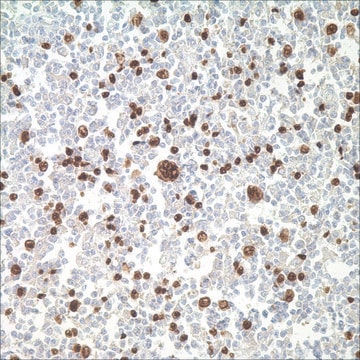推荐产品
生物源
mouse
品質等級
100
500
共軛
unconjugated
抗體表格
culture supernatant
抗體產品種類
primary antibodies
無性繁殖
24, monoclonal
描述
For In Vitro Diagnostic Use in Select Regions (See Chart)
形狀
buffered aqueous solution
物種活性
human
包裝
bottle of 1.0 mL predilute (312M-17)
bottle of 7.0 mL predilute (312M-18)
製造商/商標名
Cell Marque™
技術
immunohistochemistry (formalin-fixed, paraffin-embedded sections): 1:100-1:500
同型
IgG1
控制
tonsil
運輸包裝
wet ice
儲存溫度
2-8°C
視覺化
nuclear
基因資訊
human ... PAX5(5079)
一般說明
PAX-5 encodes for B-cell-specific activator protein (BSAP), a marker for B-cells, including B-lymphoblastic neoplasms and maturation stage. It is found in most cases of mature and precursor B-cell non-Hodgkin lymphomas/leukemias. In approximately 97% of cases of classic Hodgkin lymphoma, Reed-Sternberg cells express PAX-5. PAX-5 is not detected in multiple myeloma and solitary plasmacytoma, making it useful for such differentiation. Diffuse large B-cell lymphomas do express PAX-5, save for those with terminal B-cell differentiation. T-cell neoplasms do not stain with anti-PAX-5. There is a strong association with CD20 expression.
品質
 IVD |  IVD |  IVD |  RUO |
聯結
PAX-5 Positive Control Slides, Product No. 312S, are available for immunohistochemistry (formalin-fixed, paraffin-embedded sections).
外觀
Solution in Tris Buffer, pH 7.3-7.7, with 1% BSA and <0.1% Sodium Azide
準備報告
Download the IFU specific to your product lot and formatNote: This requires a keycode which can be found on your packaging or product label.
其他說明
For Technical Service please contact: 800-665-7284 or email: service@cellmarque.com
法律資訊
Cell Marque is a trademark of Merck KGaA, Darmstadt, Germany
Not finding the right product?
Try our 产品选型工具.
Brunangelo Falini et al.
Blood, 99(2), 409-426 (2002-01-10)
Acquired chromosomal anomalies (most commonly translocations) in lymphoma and leukemia usually result in either activation of a quiescent gene (by means of immunoglobulin or T-cell-receptor promotors) and expression of an intact protein product, or creation of a fusion gene encoding
Ines Schwering et al.
Blood, 101(4), 1505-1512 (2002-10-24)
Hodgkin and Reed-Sternberg (HRS) cells represent the malignant cells in classical Hodgkin lymphoma (HL). Because their immunophenotype cannot be attributed to any normal cell of the hematopoietic lineage, the origin of HRS cells has been controversially discussed, but molecular studies
Emina Torlakovic et al.
The American journal of surgical pathology, 26(10), 1343-1350 (2002-10-03)
Whereas L26 (anti-CD20) is well established as a B-cell marker of high specificity for use in paraffin-embedded tissues and JCB117 (anti-CD79a) is increasingly used, a comparable additional pan-B-cell antibody has hitherto not yet been identified. Here we have studied the
Klaus Willenbrock et al.
Laboratory investigation; a journal of technical methods and pathology, 82(9), 1103-1109 (2002-09-10)
The atypical cells of CD30(+) cutaneous lymphoproliferative disorders (CD30CLD) are commonly of T-cell origin and frequently have a similar morphology as Hodgkin or Reed-Sternberg cells of Hodgkin's lymphoma (HL). HL is one of the tumors associated with CD30CLD. Although most
我们的科学家团队拥有各种研究领域经验,包括生命科学、材料科学、化学合成、色谱、分析及许多其他领域.
联系技术服务部门








